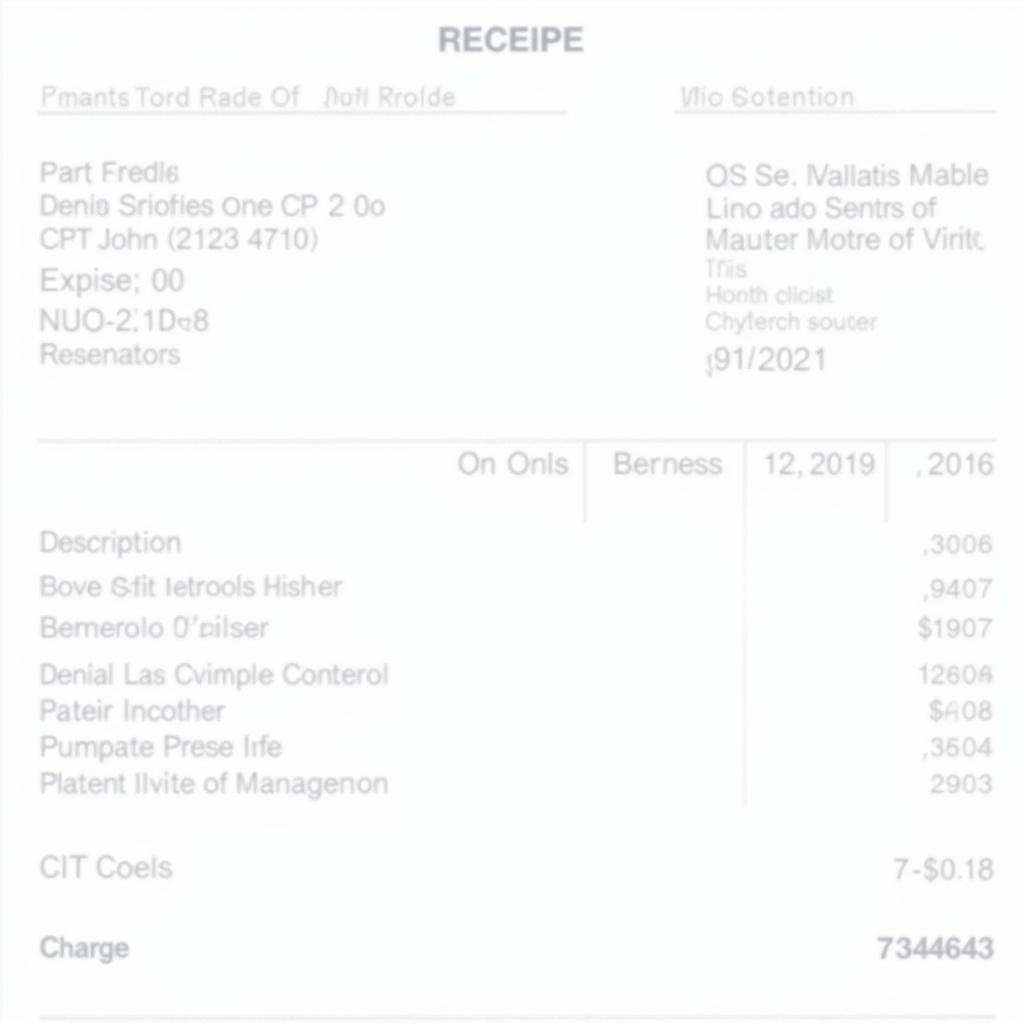A receipt of health care services is a crucial document that confirms you received specific medical services. It outlines the services provided, the date of service, the provider’s information, and the cost. This seemingly simple piece of paper plays a significant role in managing your healthcare expenses, insurance claims, and even your taxes. Understanding its components and importance can save you time, money, and potential headaches down the road.
Decoding Your Receipt of Health Care Services
A standard receipt of healthcare services contains several key elements. These details work together to paint a clear picture of the care you received. Let’s break down the essential components:
- Patient Information: This section identifies you as the recipient of the services. It typically includes your name, address, and date of birth. Sometimes, it may also include your insurance information.
- Provider Information: This section identifies the healthcare professional or facility that provided the service. It includes the provider’s name, address, and contact information. This is important for verifying the legitimacy of the service and for insurance purposes.
- Date of Service: This specifies when the service was rendered. It’s essential for tracking your medical history and for insurance claims, which often have specific filing deadlines.
- Description of Services: This section details the specific medical procedures or treatments you received. It should be clear and concise, using medical terminology that reflects the service provided.
- Service Codes (CPT/HCPCS): These alphanumeric codes represent specific medical procedures and services. They are standardized across the healthcare industry and are crucial for billing and insurance purposes.
- Charges/Fees: This section lists the cost of each service provided. It will typically outline the provider’s fee and any applicable adjustments, such as discounts or insurance payments.
Understanding these elements empowers you to effectively manage your healthcare expenses and navigate the complexities of insurance claims. Having a clear record of your healthcare journey is invaluable for both your financial and physical well-being. If you are unsure about what services are deductible, you may want to check out if in home care services are deductible on your taxes.
Why is a Receipt of Health Care Services Important?
Beyond serving as proof of payment, a receipt of health care services plays a vital role in various aspects of your healthcare management:
- Insurance Reimbursement: Receipts are the cornerstone of insurance claims. They provide the necessary documentation to substantiate your claim and receive reimbursement for eligible expenses. A detailed receipt ensures a smooth and efficient claims process.
- Tracking Medical Expenses: Maintaining organized records of your healthcare expenses is essential for budgeting and tax purposes. Receipts provide a clear record of your spending, enabling you to track your out-of-pocket costs and identify potential discrepancies. This is especially useful if you have a health savings account (HSA) or flexible spending account (FSA).
- Verifying Medical History: Receipts serve as a valuable record of your medical history, outlining the services you received and when. This information can be helpful for future medical consultations, especially when seeing a new provider.
Having a comprehensive record of your healthcare journey, especially in relation to mental health care, is crucial for future references. If you’re a Blue Care Network member, you might want to check if Blue Care Network covers mental health services.
What if I Lose My Receipt?
Losing a receipt can be frustrating, but it’s not the end of the world. Most healthcare providers maintain electronic records of your visits and can typically provide you with a duplicate receipt upon request. Contact the provider’s office and explain the situation; they should be able to assist you in obtaining a copy. Do retired service members qualify for specific healthcare benefits? Learn more about whether retired service members can get chiropractic care with Tri West.
How can I organize my healthcare receipts?
Organizing your healthcare receipts doesn’t have to be a daunting task. A simple filing system, either physical or digital, can significantly simplify the process. Consider using a designated folder or binder for paper receipts, or scan them and store them electronically. Many apps are available that can help you track and organize your medical expenses.
Conclusion
A receipt of health care services is more than just proof of payment; it’s a vital document for managing your healthcare finances, insurance claims, and medical history. Understanding its components and importance empowers you to take control of your healthcare journey. By maintaining organized records and understanding what is a receipt of health care services, you can ensure a smoother, more efficient, and ultimately, healthier experience. For those seeking information on applying for Equal Care services, you can find out how do you apply for equal care services. Similarly, you can also explore what constitutes qualified long-term care services.
FAQ
- What information is typically included on a receipt of health care services?
- Why are service codes important on a healthcare receipt?
- How can I use my receipts to track my medical expenses?
- What should I do if I lose my healthcare receipt?
- Can I submit electronic copies of my receipts for insurance reimbursement?
- Are there any apps that can help me organize my healthcare receipts?
- How long should I keep my healthcare receipts?
For any further assistance, please contact us via WhatsApp: +1(641)206-8880, Email: [email protected] or visit our office at 456 Oak Avenue, Miami, FL 33101, USA. We have a 24/7 customer support team available to assist you.



